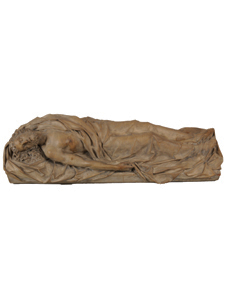Reclining Christ (Hall 28)

19th century Catalan sculpture can also be found in the permanent collection at the Frederic Marès Museum. Starting with neoclassicism it continues with works by such artists as the Venanci Brothers and Agapit Vallmitjana (in fact, the museum has numerous drawings by these artists of the apostolates from the Cathedral of Barcelona and Montserrat Monastery). Rossend Nobas is also represented. All of these artists are quite popular for their historical realism.
Agapit Vallmitjana is also considered to be one of the most relevant Spanish sculptors of his time.
This Christ figure (together with two terracotta pieces in the museum's collection) served as a study for a marble work from 1872 that can be found in the Prado Museum. Vallmitjana, heir to the Spanish sculptural tradition of reclining Christs, uses this piece to express his romantic vision of the defeated Christ-as-man. We know that the model was his good friend, the painter Eduardo Rosales. At the time of sitting, he was a very sick young man, making his physical appearance perfect for the fallen Christ figure.
The piece was very well received in its day; so well, in fact, that Vallmitjana repeated it on several successive occasions. This work dates back to 1869. The marble sculpture won first prize in Vienna in 1873 and again in Madrid in 1876, which speaks to the quality of the artist's work. Upon visiting the sculptor's studio, Queen Isabella II commissioned a marble grouping showing the queen herself presenting her son, the future King Alfonso XII. Today, this work can be found in the gardens of Pedralbes Palace in Barcelona.


